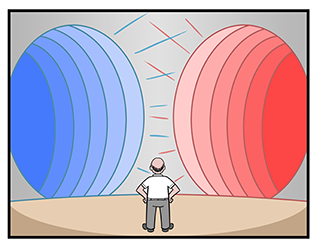
Identify Media Bias
Everyone has their own interests. Everyone has their own opinions. Everyone has their own perspectives.
This multitude of views is great. But when each news organization or media conglomerate is only running stories that support their political views or protecting their affiliate organizations, how do we find factual news?
Many people have become fed up with the news media lately. This frustration has fueled the creation of resources that map the political orientation of news agencies. To combat this irritation with media outlets, many organizations have created helpful resources that categorize the biases of news agencies.
All Sides News attempts to give a variety of perspectives by showing users sources from different sides of the political spectrum. Media Bias/Fact Check categorizes news sources based on their political orientation and gives a clear write up that offers reasons for placing the sources where they do. Finally, the Media Bias Chart places popular news sources on a chart based on their political leaning and original fact reporting. Read more about each of these resources below!
It is important to note that we are not endorsing one of these resources as being accurate. We have provided a number of resources that chart media bias to offer a range of views. You might notice that the three resources categorize news organizations differently. Always remember to apply your critical thinking skills when consulting one of these resources.
AllSides
Created by three people who identify on different sides of the political spectrum – John Gable, Scott McDonald, and Joan Blades – AllSides.com is a resource that aims to show “all sides” of news stories.
The site offers a news feed where current news stories from sources on different sides of the political spectrum are compared. Users can also view ratings for hundreds of news sources. After clicking on one of these news sources, the site explains their reasoning behind each categorization. At the bottom of individual site pages, All Sides lists the data used to arrive at this rating and their confidence in this rating. Visitors to the site can also “agree” or “disagree” with the rating provided by the website. This function seems to act as a check on the ratings given by the AllSides team.
Media Bias/Fact Check
Media Bias/ Fact Check (MBFC) was established in 2015 and encourages people to reject overtly biased media. Edited by Dave van Zandt, the site uses a complex methodology when categorizing news sources.
Each page has a political spectrum scale and places the site on this scale. The site’s placing is determined by political bias or factual reporting and in some cases, both of these scorings. Users can also vote on where they would place each news source. While the users’ input is not considered in the original scoring, MBFC states that this data is used to offer another perspective about the rankings given. Viewers can see if people agree or disagree with MBFC’s rating of news sources. Visit MBFC’s methodology page to read more about their methods.
Media Bias Chart
Created by Vanessa Otero, a patent attorney, the Media Bias Chart aims to help people find reliable, unbiased news. Like All Sides and Media Bias/Fact Check, fact checkers scan articles from news outlets and rank them according to the site’s methodology. This screening process relies heavily on an analysis of the articles’ bias and factual reporting. Many other factors are taken into consideration. For example, the site analyzes the number and type of guests that a show has on their program and the behavior that the host has with the host. The folks at media bias chart use a small number of articles from each news outlet as a sample and hope that their data will become more representative of the whole source as they examine more articles.
Otero’s chart is useful as a quick reference. However, unlike the other resources, a description of how the site was categorized is not offered underneath each entry. As always, learn about the practices that Media Bias Chart’s team uses by reading their methodology whenever deciding whether or not to agree with their categorization.
